
11 Best Shed Roofing Ideas and Materials
Your shed’s roof is perhaps the most critical component of the entire structure. Without a sound and solid roof, it won’t be long before your shed’s contents are exposed to the elements and whatever small critters are lurking in your neighborhood.
Fortunately, tons of different quality roofing materials can protect your shed and everything inside it for decades to come. In this article, we’ll take a closer look at the best shed roofing ideas and materials to help you decide on the perfect material for your next home project.
Best Ideas and Options For Shed Roofing Materials
Over a dozen different materials make an excellent choice as a roofing material for your shed. However, the 11 materials below have stood the test of time as the premier roofing materials for sheds.
1. Asphalt Roof Shingles
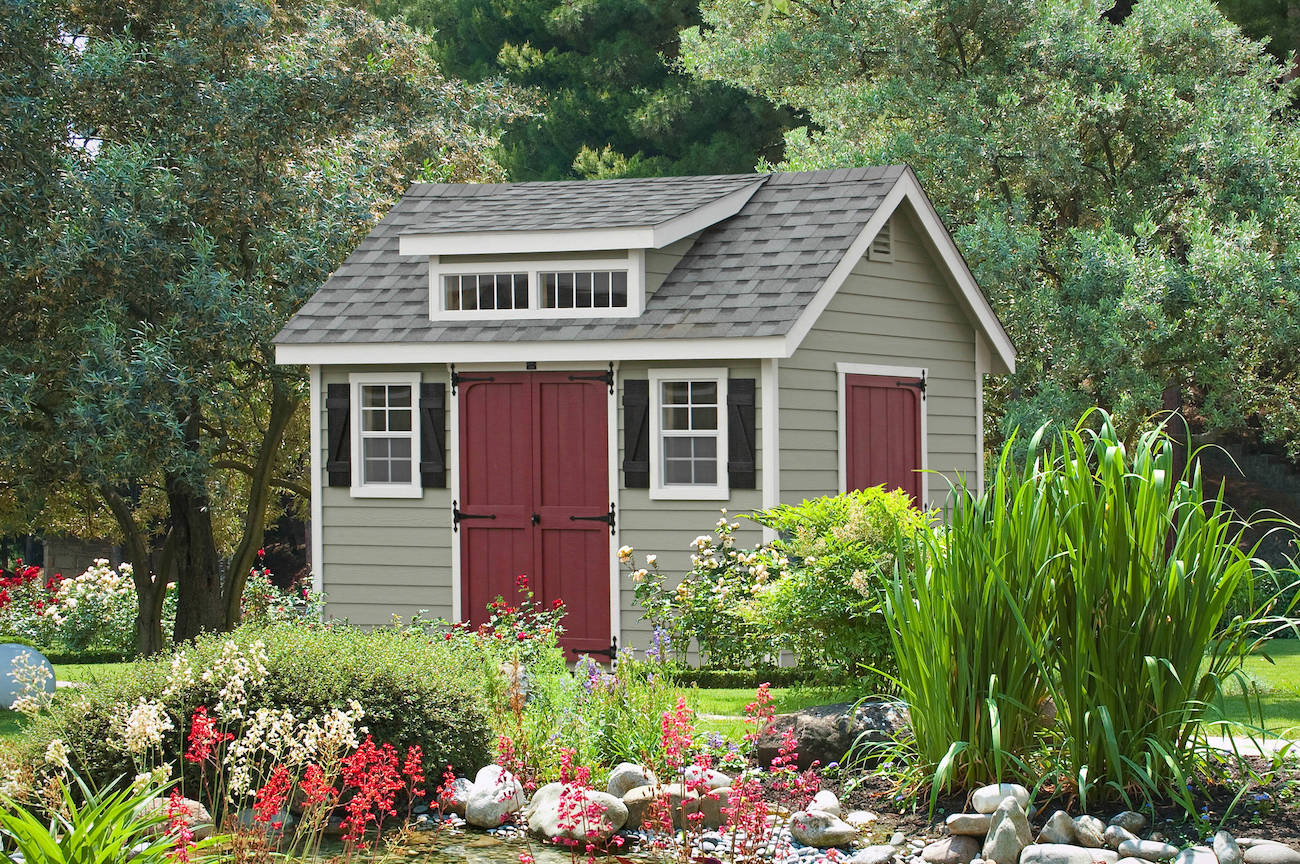
Asphalt roof shingles are among the most popular choices for all roofing applications. This material is affordable, durable, easy to install, and suitable for many roof styles.
Asphalt shingles come in three styles: three-tab shingles, dimensional shingles, and luxury singles.
Three-tab shingles lay flat on the roof, the most common type of asphalt shingle. They’re the most affordable of the three; they’re durable and relatively easy to install.
Dimensional shingles feature a gradient look that creates an attractive random pattern on the roof. These shingles are more durable than three-tab models, and you can install them easily.
Luxury shingles are the most attractive of the three, with a three-dimensional profile that resembles a slate roof. These shingles are the most durable, but they’re also the most expensive. It’s common for luxury shingles to cost twice the price of dimensional shingles.
For cost reasons, most homeowners choose a three-tab or dimensional shingle for their shed roofs. These two materials are easiest to install and require very little in terms of tools or equipment.
Read More: Cost Of Building A Shed Vs Buying
When installed properly, asphalt shingles can last between 15-30 years, depending on the roof’s style, quality, and upkeep. It’s common for asphalt shingles to carry a more extended warranty period. Still, getting the company to honor the warranty is often challenging unless a manufacturer’s partner does the installation.
Pros
- Simple installation
- Excellent durability
- Reasonably inexpensive
Cons
- Direct sunlight can cause damage
- Not applicable to flat roofs
2. Cedar Shingles
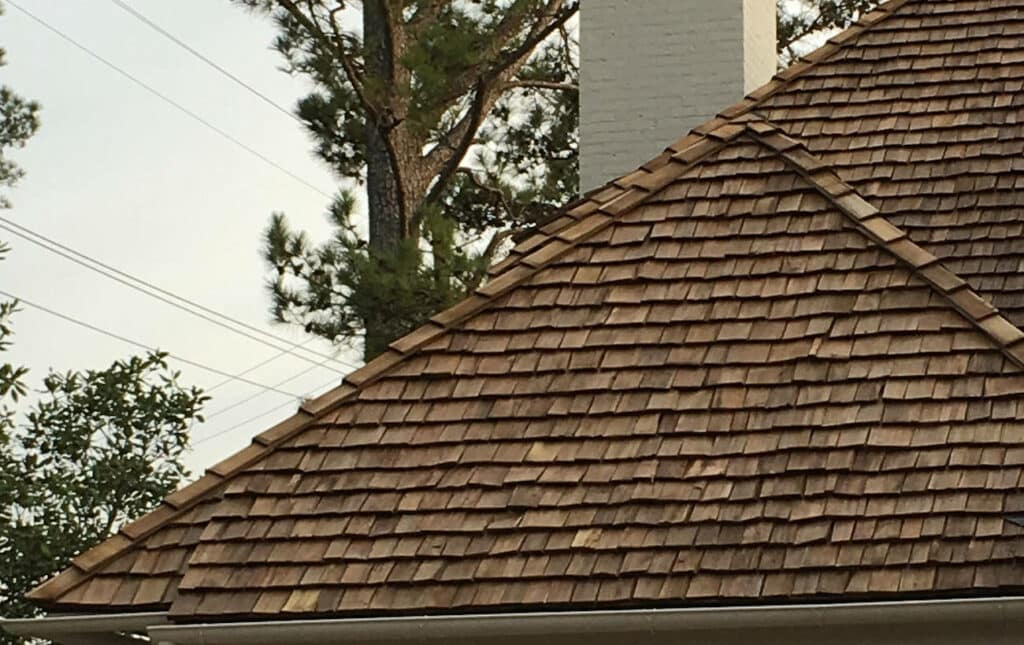
Cedar shingles are one of the most striking roofing materials available, and it’s a perfect way to bring some classic Americana to your backyard. These roofs have been popular since the 19th century for their distinctive style, and when it comes to the best shed roofing ideas and materials, cedar shingles are among the most popular with professional designers.
Cedar shingles are made from cedar trees harvested in the Northwest of the U.S. and Southwest of Canada. The trees are processed into small sections and then sawn by hand to produce shake roofing or with a saw to make shingles.
This roofing material is sold by grade, with three grades available: common, select, and straight grain.
Straight grain is the highest grade, with all pieces featuring a straight and uniform grain pattern. These hand-selected pieces are the most visually appealing and durable of the bunch. Select grain is made up predominantly of straight-grain wood, with some common grade mixed in.
The lowest of the three grades is common, and it’s composed of wood with an imperfect grain and may have splits or blemishes. Not only is this grade less attractive, but it’s also more prone to warping and breakage.
Installing a cedar shingle roof is a bit more complicated than materials like asphalt shingles or roofing panels, and most people leave it to a qualified contractor. However, regardless of who handles the installation, you can anticipate a cedar roof to be one of the most expensive styles available.
Pros
- Beautiful and distinguished looks
- Excellent durability
- Superior insulation
Cons
- Challenging installation
- Requires regular maintenance
- Expensive
3. Wood Shakes
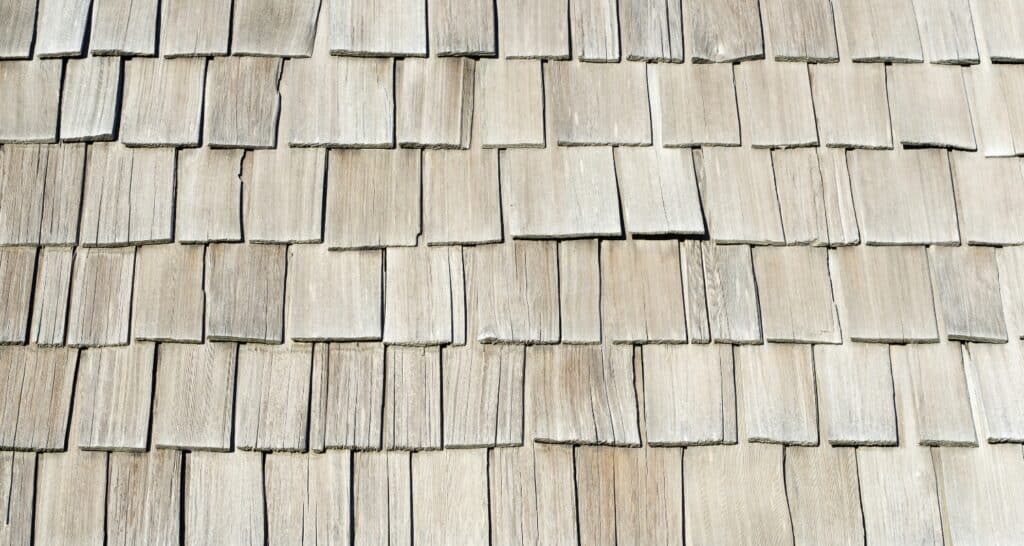
Like cedar roofs, a wooden shake roof is an excellent way to channel a country look, and it may be a perfect way to complement your home and yard.
Wooden shake roofing is typically made from cedar, cypress, redwood, or oak. Once a tree is processed into smaller sections, the pieces are hand split, which creates the rough and uneven texture shake roofing is known for.
Compared to wooden shingles, shake roofs offer a more primitive and less polished style, and each shake is a slightly different size and shape. Shake is also a bit thicker than wooden shingles, and the grain pattern can vary significantly.
Since each piece is unique, shake roofs are more prone to damage than other roofing styles, including wooden shingles. Shake roofs are less waterproof and windproof and often require maintenance to maintain the roof’s integrity. Since this material is less waterproof, you’ll also want to avoid it if your roof has a pitch less than 12/4.
While they aren’t as durable or polished as a shingle roof, shake is a much more affordable alternative, at least for your material costs. Proper installation of a shake roof is complex, and you need experience and skill to install one properly. However, when professionally installed, homeowners are rewarded with a beautiful and durable roof that channels colonial America.
Pros
- Less expensive than wooden shingles
- Excellent insulation
- Distinct look
Cons
- Challenging installation
- Less weatherproof than most materials
- Requires regular maintenance
4. Metal Shingles
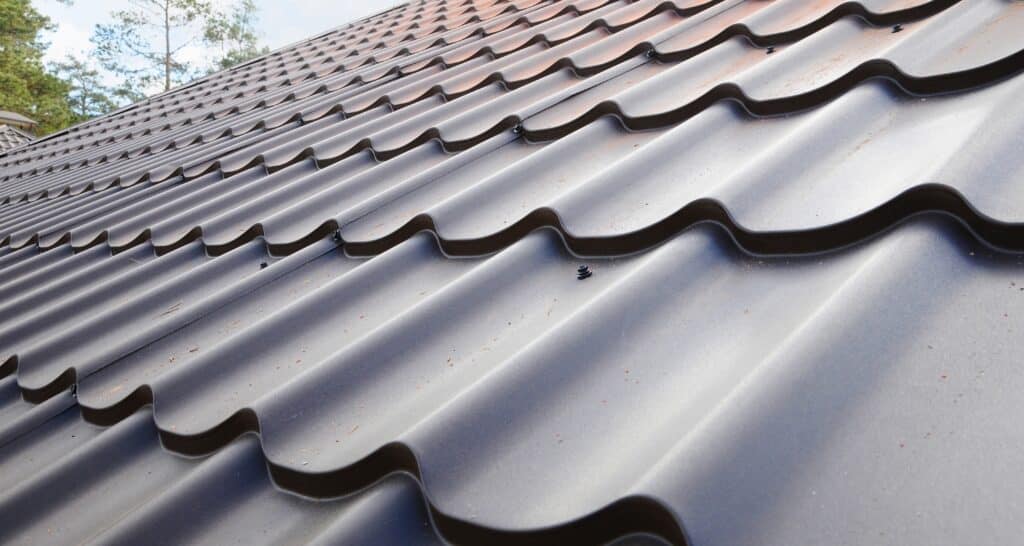
Metal shingles are a unique alternative to traditional roofing systems such as corrugated or asphalt roofing. Most styles of metal roofing are typically seen in industrial and agricultural applications, but metal shingles can replicate a variety of roofing styles, and they’re among the most high-end roofing options.
Metal roofing has been used for over 100 years, but the invention of stone coating in the 50s helped open metal roofing to a new world of possibilities. These stone-coated roofing products begin like other metal roofing sheets and are stamped into different shapes and styles before being coated with a resilient stone product.
These shingles can replicate the look of wooden shingles or shake, asphalt shingles, and even brick. Most importantly, they carry the enhanced durability that metal provides, and they often last substantially longer than the roofing materials they mimic.
Metal shingles have a few different characteristics, making them an excellent choice for roofing your shed. Most importantly, they’re exceptionally durable, and metal shingle roofs can last over 70 years when properly maintained. Metal shingles also require much less maintenance than wood shingle, shake, or asphalt roofing.
Some insurance companies offer discounts for homes and structures with metal roofing since the material is durable, low maintenance, and more resistant to severe weather than other forms of roofing.
Metal shingles are also available at a broad range of price points depending on your needs and budget. Stone-coated shingles, especially those with more elaborate designs, command higher prices. Less aesthetic metal shingles are much more affordable while providing all the benefits of metal roofing.
Pros
- Unbeatable durability
- Excellent insulation and UV resistance
- Lasts up to 70 years
Cons
- Can be substantially more expensive than other roofing types
- Not a good choice for coastal environments (material can rust)
5. Clay Tiles
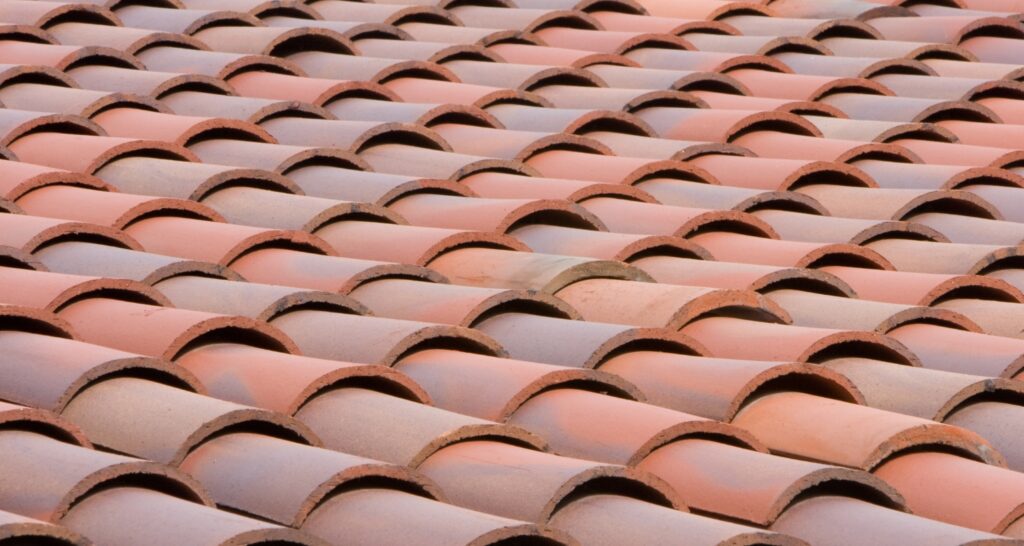
Clay tiles are one of the most visually striking roof styles available, and they’re also the most durable roofing material you can use.
Clay tiles have been popular for over a century, especially in coastal climates that cause trouble with other roofing products, such as metal or wood shingles. These tiles are made by shaping natural clay and baking it at extremely high temperatures. The baking process helps make the tiles dense while also locking in their color for the roof’s lifetime.
The most common clay tiles are terra cotta colored, but you’ll find other shades of tan, orange, brown, and red. Clay tiles also come in several styles to suit the needs of different homes and sheds.
Spanish tiles are the most popular, and they feature large troughs in each row of tiles to carry water away from the roof. Scandia tiles are similar to Spanish tiles but installed in the opposite direction, delivering a more dramatic look. Double Roman tiles are most common in Mediterranean areas, similar to Spanish tiles but with narrower troughs.
There are also more styles, including shake, pantile, barrel, Riviera, and French tiles. While these tiles offer a dramatic look for homes, they’re less applicable to installing a shed roof.
Clay tiles deliver the most extended lifespan of any roofing material and are also exceptionally durable. This material is impervious to rotting and inhibits mold and moss growth.
This roofing material is more expensive than most, but the long lifespan of the roof offsets the additional cost. Clay tiles can last upward of 100 years when installed and maintained correctly.
Pros
- Beautiful and distinct look
- Longest-lasting roofing material
- Made from natural and recyclable materials
Cons
- Tiles can crack easily and must be changed when cracked
- Expensive
- Challenging installation
6. Rubber Shingles
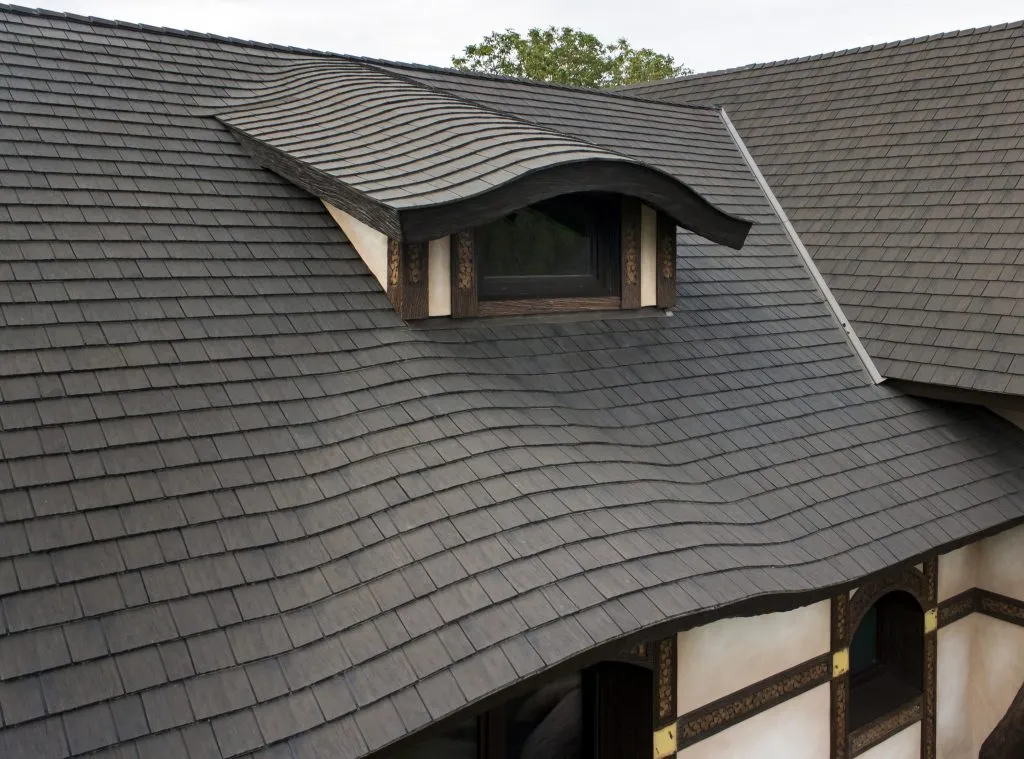
Rubber shingles are an excellent choice for several different reasons as the material for your next shed roof. Compared to other roofing materials, rubber shingles are more affordable without sacrificing durability.
Rubber shingles can be made in various shapes, colors, and styles, and they’re made to resemble other popular roofing products, such as luxury asphalt shingles or wood shake. One of the significant benefits of rubber shingles is that they’re easy to install, allowing DIYers to take advantage of the look of a more expensive roof without hiring a qualified installer.
Rubber shingles have a lifespan comparable to most three-tab or dimensional asphalt shingle roofs. This material is low maintenance and resistant to UV damage. Rubber is also an excellent insulator, so it will help regulate the temperature inside the shed.
One of the most significant benefits of rubber roofing is that it is easy to install and repair if an area of the roof begins to leak. Replacing the affected section is easy; all it takes is some quality roofing sealant to fix the issue permanently.
Rubber shingles can also be installed on various roof styles regardless of pitch, making them more versatile than materials that only work well on certain roofs. When properly installed, a rubber shingle roof should provide a 15-30 year lifespan, and most products carry a 30-year warranty.
Pros
- Mimics the look of other, more expensive roofing products
- Easy to install
- Easy to repair
Cons
- Requires regular maintenance to prevent black mold
- New installations have a distinct odor
7. Board-and-Batten

Board-and-batten roofing is one of the oldest roofing styles, and it’s the perfect roof to choose for a rustic shed in a classic American style. Board-and-batten roofing is inexpensive compared to other types of roofing products, and it provides a decent lifespan to go along with rustic good looks.
This type of roofing gets its name from the two components that make up the roofing system. The boards run vertically across the length of the roof, and they’re attached to the battens, which are horizontal boards mounted to the roof rafters.
Most systems feature battens installed 24″ apart on center, with boards ranging from 3-12″ wide used to complete the roof.
Board-and-batten roofing isn’t waterproof, so it’s critical that you properly install a quality roofing membrane to protect the contents of your shed. A board-and-batten roof should last for 20-30 years when properly installed.
To maximize the life of a board-and-batten roof, you’ll need to perform occasional maintenance to remove dead leaves and other debris to prevent water damage or rotting. Any damaged boards should be replaced to maximize the roof’s lifespan. This roofing style is also highly susceptible to UV damage, so a UV-resistant sealant should be used to prevent damage.
Pros
- Cost-effective
- Easy to install and maintain
- Highly impact and weather resistant
Cons
- Not waterproof
- Requires regular maintenance
8. Corrugated Roofing Panels

Corrugated roofing panels have been a prevalent roofing material for industrial and agricultural applications for over 100 years. These panels can be made from a broad range of materials, and they’re among the most cost-effective roofing solutions for your shed.
Corrugated panels can be made from many materials; cement, fiberglass, plastic, and metal are the most popular. Depending on your climate and the expectations for your roof’s lifespan, you may find one of these materials to be best suited for you. Metal, fiberglass, and plastic are the most commonly used materials for installing a corrugated roof on a shed.
Regardless of the material, corrugated panels are made into sheets with deep troughs, similar to a clay tile roof. These troughs help with drainage and ensure water isn’t sitting on the roof. Most corrugated roofing materials are inherently waterproof, so they can be installed on flat roofs with virtually no pitch.
Corrugated roofing is affordable, and the large size of each panel means you can quickly install an entire roof in less than half the time it would take to install a more complicated roofing system. Corrugated systems are also easy to maintain and repair, so it’s an excellent choice for homeowners worried about maintaining a more complex roofing system.
Pros
- Inexpensive
- Easy to install
- Can be installed on flat or pitched roofs
Cons
- Not as attractive as other roof styles
- Not as durable as other roofing systems
9. Asphalt Roofing Felt
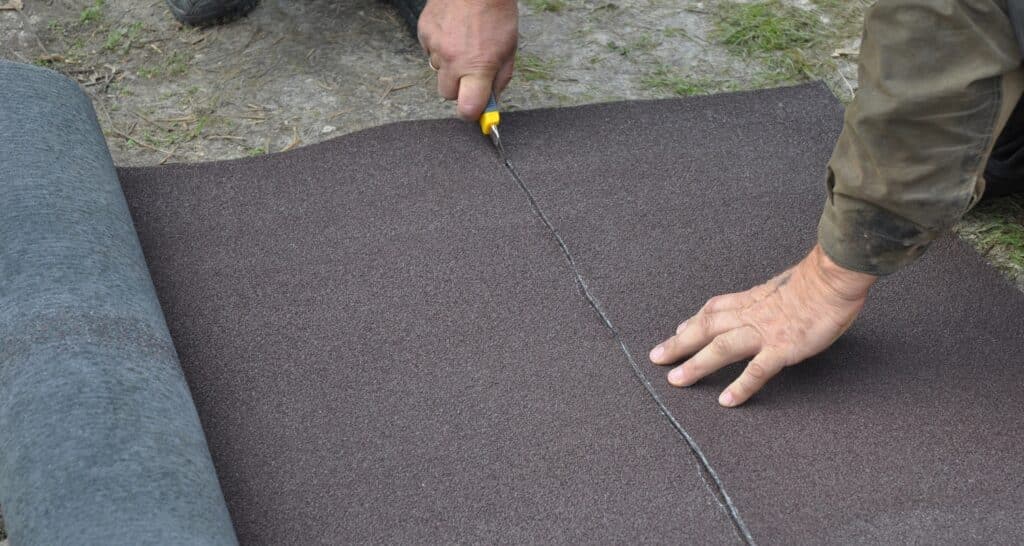
While roofing felt is traditionally used as an underlayment to protect roof decking from the elements, asphalt roofing felt can be installed as a standalone product. This is the most cost-effective roofing material, and it can be installed on many different roof styles.
Asphalt roofing felt has a core made from felt, with an application of asphaltic roofing material to each side of the material. This coating helps protect the roofing material from wear and damage. Asphalt roofing can either be installed with an adhesive or with the torch-down method.
Asphalt roofing felt is typically installed on flat roofs but can also be installed on pitched roofs. Both installation methods are effective, while the torch-down method is preferred when roofing in cold climates that rarely reach above 60 degrees. For warmer climates, installation with adhesive is the most economical method.
Asphalt roofing felt is relatively inexpensive; it’s reasonably durable and will last between 10-20 years. The product comes in rolls, which are easy to cut to size, so installation is a breeze. You need to exercise care during installation to ensure the material adheres correctly and there are proper overlaps for each seam.
Pros
- Easy to install
- Affordable
- Impact resistant
Cons
- Not as visually appealing as other roofing styles
- Shorter lifespan than most other materials
10. Polycarbonate Roofing Panel

Polycarbonate roofing panels are another relatively inexpensive roofing material that can make an excellent choice for specific applications.
This material is typically corrugated, and it’s made from polycarbonate. Compared to other plastics, polycarbonate is exceptionally strong and flexible. It’s also crystal clear, which makes it an excellent choice for roofs over greenhouses, patios, and porches.
Beyond clear plastic, these panels are also available in different colors that mimic the look of clay tiles or metal roofing, making them an excellent choice for sheds.
Polycarbonate roofing panels are usually sold in 6-12′ lengths, with each panel around 26″ wide, and it’s among the most inexpensive roofing materials.
The unique characteristics of polycarbonate make it much stronger than fiberglass and less prone to denting and damage than corrugated metal panels. As a result, a polycarbonate roof installed correctly can last up to 20 years. However, scratching and discoloration will usually lead homeowners to replace their polycarbonate roof before it begins to fail.
Pros
- Inexpensive
- Perfect choice for applications where you need as much natural light as possible
- Fairly easy to install
Cons
- Prone to scratching and discoloration
- Mediocre durability
11. EPDM Rubber Roofing Membrane
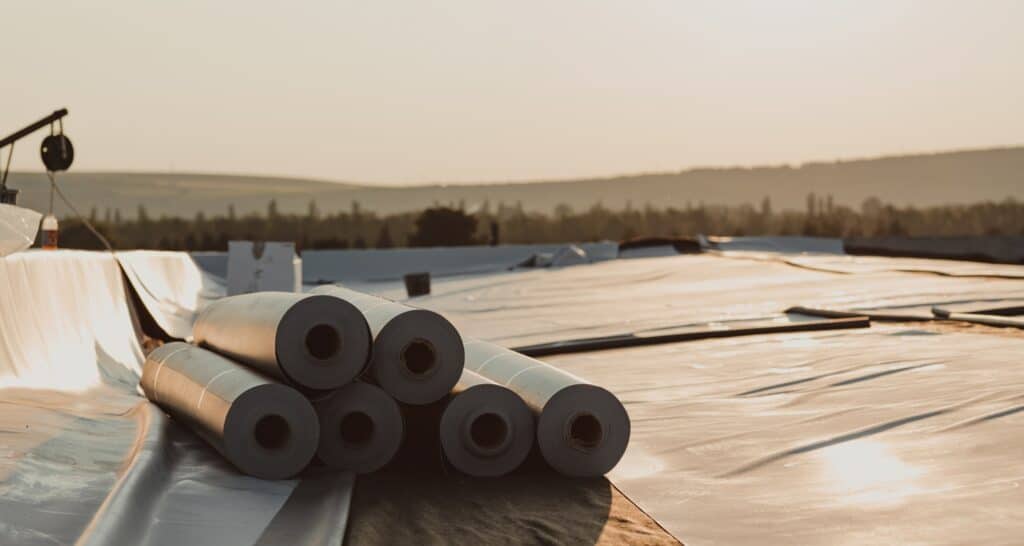
An affordable and long-lasting product that’s an excellent choice for supply sheds and other structures that don’t need to be aesthetically pleasing, EPDM rubber roofing membrane is worth looking at more closely.
The material is made from recycled rubber sold in rolls, and it’s available in thicknesses ranging from 1 to 2 ½ millimeters. Thinner material is designed to last 12-15 years, while the thicker membrane can last for 25 years or more.
You can install EPDM in several different ways. The most secure and durable way to install it is by adhering it directly to the roof panels. It can also be installed with fasteners, although the holes the fasteners create may compromise how waterproof the roof is. The final way is a ballasted installation, where the rolls are loose-laid and covered in paving stones or rocks.
EPDM is only available in white or black, so many homeowners paint it the color they choose after installation. However, black is a common choice, as it’s significantly less expensive than white EPDM.
This material is highly weather and impact-resistant but susceptible to punctures from falling branches or debris. An EPDM roof needs to be regularly inspected, and you should patch any holes in the roof. Occasional maintenance will ensure the roofing material provides your shed with years of protection.
Pros
- Inexpensive
- Excellent choice for flat roofs
- Durable and easy to maintain
Cons
- Only available in two colors
- Requires professional installation
Consider These Factors When Choosing Shed Roofing Material
Regarding roofing materials, there isn’t a one-size-fits-all answer to which roofing material will be best for your projects. Instead, several factors influence how different materials will perform, and you’ll want to consider each before you choose a roofing material.
Lifespan
One of the first things you’ll want to consider is how long you’ll need the roof to last. For a temporary structure or a shed you plan on replacing in the next ten years or so, you may not want to consider more durable and expensive roofing materials. Conversely, if you’re installing a new shed you plan to use for decades, you’ll want to consider a roof with a longer lifespan.
The lifespan you’ll get out of each roofing material will vary significantly depending on your climate, the regularity of severe weather, and how well the roof was installed. However, as a general rule, clay or slate tile and metal roofs provide the most extended lifespan, while rubber, shingle, and rolled roofing products don’t last nearly as long.
Warranty
For most homeowners, a roofing product’s warranty is critically essential. Still, warranties for home products such as roofing materials are often difficult to understand and redeem.
Many manufacturers only honor warranty claims for roofing material installed by approved contractors. Even if the installation was approved, lack of maintenance or environmental issues might also void the warranty. In some cases, the additional cost of a professional installation outweighs the benefit the warranty provides.
Whether you plan to take advantage of the warranty or not, it’s usually a general indicator of how long you can expect a particular roofing material to last.
Appearance
Another significant concern for most homeowners is the appearance of their shed’s roof. Some sheds are strictly utility structures that aren’t especially appealing, while others are beautiful and look like miniature versions of stately homes.
A simple shed for housing garden tools might require a different aesthetic consideration than a designer shed that adds beauty to your yard instead of detracting from it. Shingles made from clay tile, wood, or slate are typically the most beautiful, while shake and board-and-batten roofing lend a more rustic appeal.
For installations where aesthetics aren’t necessary, corrugated roofing, EPDM, and asphalt roofing felt are all excellent and cost-effective choices.
Durability
How durable the material is can also be crucial to the decision-making process. A durable roof provides a longer lifespan, but more durable materials generally require less maintenance and are less likely to be damaged by severe weather.
Metal roofing is usually the most durable and impervious to damage. Clay, wood, and slate tile roofs are also exceptionally durable, but the individual shingles are fragile and can easily be broken by fallen debris. Rubber and asphalt shingles are the least durable but are usually more durable than rolled rubber or polycarbonate materials.
Price
Roofing materials are available in many styles and run the gamut of price points. Beyond the style of the roof, durability also influences price. You can expect a beautiful and durable roof to command the highest prices, while the less aesthetic options are much cheaper.
Read More: Cheapest Way To Build a Shed (For The Frugal DIY)
For homeowners on a budget hoping to achieve a more high-end look, materials such as rubber shingles allow them to mimic a high-end look with a more economical material that’s in line with budgetary needs.
Installation
Whether installing the roof on your own or hiring a professional, the installation process may be of particular concern for you.
For DIYers, corrugated roofing panels and asphalt shingles are usually the easiest to install, while shingle and shake roof systems are a bit more challenging. Most tile roofing systems are better left to professionals.
Maintenance
Depending on the roofing material you choose, you may not need to perform any maintenance. For others, regular maintenance is the only way to prevent the roof from failing and maximize its lifespan.
Metal shingle roofs typically require the least maintenance. Tile and slate roofs are also relatively low maintenance, although you can expect to have to change broken tiles out occasionally. Other shingle roofs and board-and-batten and EPDM roofs will require occasional maintenance to remove leaves, standing water, or other debris.
Roof Pitch
Your roof’s pitch can significantly impact the type of roofing material that’s best for you. Some materials can be installed on flat or pitched roofs, but several can only be installed on a pitched roof.
Shingle roofs rely on gravity to keep water running off the roof and away from the shed, and they cannot be installed on flat roofs. Some materials, such as board-and-batten roofing systems, require a more significant pitch than other styles.
Conversely, rolled asphalt felt and EDPM products are almost always installed on flat roofs, where gravity isn’t necessary to maintain the waterproof properties of the roof.
In climates that receive significant rain or snowfall, a roof with a higher pitch will generally last longer than a flatter roof, as they’re able to release water more quickly.
Final Word
The right roofing material can make all the difference to the look and durability of your shed. As you research the best shed roofing ideas and materials, you’ll want to carefully consider your needs, budget, and location to select the best material for the job. A quality roof installed properly should protect your shed and everything inside it for decades.
